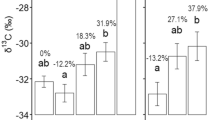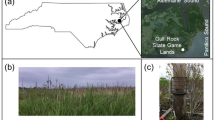Abstract
Climate and parent material strongly control vegetation structure and function, yet their control over the belowground microbial community is poorly understood. We assessed variation in microbial lipid profiles in undisturbed forest soils (organic and surface mineral horizons) along an altitudinal gradient (700, 1,700, and 2,700 m a.s.l. mean annual temperature of 12–24°C) on two contrasting parent materials (acidic metasedimentary vs. ultrabasic igneous rock) in Mt. Kinabalu, Borneo. Soil organic carbon and nitrogen concentrations were generally higher at higher altitudes and, within a site, at upper soil horizons. Soil pH ranged from 3.9 to 5.3, with higher values for the ultrabasic soils especially at higher altitudes. The major shifts in microbial community structure observed were the decline in the ratio of fungal to bacterial lipid markers both with increasing soil depth and decreasing altitude. The positive correlation between this ratio with soil C and N concentrations suggested a strong substrate control in accord with the literature from mid to high-latitude ecosystems. Principal component analysis using seven groups of signature lipids suggested a significant altitude by parent material interaction—the significant difference in microbial community structure between the two rock types found at 2,700-m sites developed on weakly weathered soils diminished with decreasing altitude towards 700-m sites where soils were strongly weathered. These results are consistent with the hypothesis that parent material effect on soil microbial community (either directly via soil geochemistry or indirectly via floristic composition) is stronger at an earlier stage of ecosystem development.



Similar content being viewed by others
References
Aiba SI, Kitayama K (1999) Structure, composition and species diversity in an altitude-substrate matrix of rain forest tree communities on Mount Kinabalu, Borneo. Plant Ecol 140:139–157
Aiba S-i, Kitayama K, Takyu M (2004) Habitat associations with topography and canopy structure of tree species in a tropical montane forest on Mount Kinabalu, Borneo. Vegetatio 174:147–161
Allison VJ, Yermakov Z, Miller RM, Jastrow JD, Matamala R (2007) Using landscape and depth gradients to decouple the impact of correlated environmental variables on soil microbial community composition. Soil Biol Biochem 39:505–516
Bääth E, Anderson TH (2003) Comparison of soil fungal/bacterial ratios in a pH gradient using physiological and PLFA-based techniques. Soil Biol Biochem 35:955–963
Balser TC, Firestone MK (2005) Linking microbial community composition and soil processes in a California annual grassland and mixed-conifer forest. Biogeochemistry 73:395–415
Balser T et al (2006) Bridging the gap between micro- and macro-scale perspectives on the role of microbial communities in global change ecology. Plant Soil 289:59–70
Blagodatskaya EV, Anderson TH (1998) Interactive effects of pH and substrate quality on the fungal-to-bacterial ratio and QCO2 of microbial communities in forest soils. Soil Biol Biochem 30:1269–1274
Bligh EG, Dyer WJ (1959) A rapid method of total lipid extraction and purification. Can J Biochem Physiol 37:911–917
Bottomley PJ, Yarwood RR, Kageyama SA, Waterstripe KE, Williams MA, Cromack K Jr, Myrold DD (2006) Responses of soil bacterial and fungal communities to reciprocal transfers of soil between adjacent coniferous forest and meadow vegetation in the Cascade Mountains of Oregon. Plant Soil 289:35–45
Carney KM, Matson PA (2005) Plant communities, soil microorganisms, and soil carbon cycling: does altering the world belowground matter to ecosystem functioning? Ecosystems 8:928–940
Chapin FSI, Mooney HA, Matson PA (2002) Principles of terrestrial ecosystem ecology. Springer, Berlin Heidelberg New York
Ekelund F, Ronn R, Christensen S (2001) Distribution with depth of protozoa, bacteria and fungi in soil profiles from three Danish forest sites. Soil Biol Biochem 33:475–481
Eskelinen A, Stark S, Männistö M (2009) Links between plant community composition, soil organic matter quality and microbial communities in contrasting tundra habitats. Oecologia 161:113–123
Fierer N, Schimel JP, Holden PA (2003) Variations in microbial community composition through two soil depth profiles. Soil Biol Biochem 35:167–176
Fierer N, Craine JM, McLauchlan K, Schimel JP (2005) Litter quality and the temperature sensitivity of decomposition. Ecology 86:320–326
Fraterrigo JM, Balser TC, Turner MG (2006) Microbial community variation and its relationship with nitrogen mineralization in historically altered forests. Ecology 87:570–576
Frostegård A, Bååth E, Tunlid A (1993) Shifts in the structure of soil microbial communities in limed forests as revealed by phospholipid fatty acid analysis. Soil Biol Biochem 25:723–730
Grayston SJ et al (2004) Assessing shifts in microbial community structure across a range of grasslands of differing management intensity using CLPP, PLFA and community DNA techniques. Appl Soil Ecol 25:63–84
Grieve IC, Proctor J, Cousins SA (1990) Soil variation with altitude on Volcan Barva, Costa Rica. Catena 17:525–534
Griffiths BS, Ritz K, Dobson G (1998) Soil microbial community structure: effects of substrate loading rates. Soil Biol Biochem 31:145–153
Gutknecht JLM (2007) Exploring long-term microbial responses to simulated global change. PhD Thesis. University of Wisconsin-Madison, Madison
Högberg MN, Högberg P, Myrold DD (2007) Is microbial community composition in boreal forest soils determined by pH, C-to-N ratio, the trees, or all three? Oecologia 150:590
Hutchinson CS (2005) Geology of North-West Borneo Sarawak Brunei and Sabah. Elsevier, Amsterdam
Jacobson G (1970) Gunong Kinabalu Area, Sabah, Malaysia. Geological Survey Malaysia, Kuching
Jenny H (1941) Factors of soil formation: a system of quantitative pedology. McGraw-Hill, New York
Kao-Kniffin J, Balser TC (2007) Elevated CO2 differentially alters belowground plant and soil microbial community structure in reed canary grass-invaded experimental wetlands. Soil Biol Biochem 39:517–525
Kitayama K (1992) Altitudinal transect study of the vegetation on Mount Kinabalu, Borneo. Vegetatio 102:149–171
Kitayama K, Aiba SI (2002) Ecosystem structure and productivity of tropical rain forests along altitudinal gradients with contrasting soil phosphorus pools on Mount Kinabalu, Borneo. J Ecol 90:37–51
Kitayama K, Aiba SI, Majalap-Lee N, Ohsawa M (1998) Soil nitrogen mineralization rates of rainforests in a matrix of elevations and geological substrates on Mount Kinabalu, Borneo. Ecol Res 13:301–312
Kitayama K, Aiba S, Takyu M, Noreen ML, Wagai R (2004) Soil phosphorus fractionation and phosphorus-use efficiency of a Bornean tropical montane rain forest during soil ageing with podzolization. Ecosystems 7:259–274
Moore J, Marjorie JL, Schulz MS, White AF, Brantley SL (2010) Shifting microbial community structure across a marine terrace grassland chronosequence, Santa Cruz, California. Soil Biol Biochem 42:21–31
Moritz L (2008) Carbon cycling and microbial communities with depth in soils from contrasting parent materials in the old-world tropics. MS Thesis. University of Wisconsin-Madison, Madison
Moritz L, Liang C, Wagai R, Kitayama K, Balser TC (2009) Vertical distribution and accumulation of microbial residues in two tropical forest soils formed from contrasting parent material. Biogeochemistry 92:83–94
Olsson PA, Bååth E, Jakobsen I, Söderström B (1995) The use of phospholipid and neutral lipid fatty acids to estimate biomass of arbuscular mycorrhizal fungi in soil. Mycol Res 99:623–629
Paul EA, Clarks FE (1996) Soil microbiology and biochemistry, 2nd edn. Academic Press, San Diego
Pietikäinen J, Pettersson M, Bääth E (2005) Comparison of temperature effects on soil respiration and bacterial and fungal growth rates. FEMS Microbiol Ecol 52:49
Potthoff M, Steenwerth KL, Jackson LE, Drenovsky RE, Scow KM, Joergensen RG (2006) Soil microbial community composition as affected by restoration practices in California grassland. Soil Biol Biochem 38:1851–1860
Raich JW, Russell AE, Kitayama K, Parton WJ, Vitousek PM (2006) Temperature influences carbon accumulation in moist tropical forests. Ecology 87:76–87
Ratledge C, Wilkinson SG (1988) Microbial lipids. Academic Press, London
Rinnan R, Michelsen A, Baath E, Jonasson S (2007) Fifteen years of climate change manipulations alter soil microbial communities in a subarctic heath ecosystem. Glob Change Biology 13:28–39
Saetre P, Bååth E (2000) Spatial variation and patterns of soil microbial community structure in a mixed spruce-birch stand. Soil Biol Biochem 32:909–917
Smithwick EAH, Mack MC, Turner MG, Chapin FS III, Zhu J, Balser TC (2005) Spatial heterogeneity and soil nitrogen dynamics in a burned black spruce forest stand: distinct controls at different scales. Biogeochemistry 76:517–537
Soil Survey Staff (1999) Soil Taxonomy, 2nd ed. Agric. Handb. No. 436, USDA, Natural Resources Conservation Service, U.S. Govt. Print. Office, Washington
Sollins P (1998) Factors influencing species composition in tropical lowland rain forest: does soil matter? Ecology 79:23–30
Tscherko D, Hammesfahr U, Marx MC, Kandeler E (2004) Shifts in rhizosphere microbial communities and enzyme activity of Poa alpina across an alpine chronosequence. Soil Biol Biochem 36:1685–1698
Ushio M, Wagai R, Balser TC, Kitayama K (2008) Variations in the soil microbial community composition of a tropical montane forest ecosystem: does tree species matter? Soil Biol Biochem 40:2699–2702
Ushio M, Kitayama K, Balser TC (2010) Tree species-mediated spatial patchiness of the composition of microbial community and physicochemical properties in the topsoils of a tropical montane forest. Soil Biol Biochem 42:1588–1595
Wagai R, Mayer LM, Kitayama K, Knicker H (2008) Climate and parent material controls on organic matter storage in surface soils: a three-pool, density-separation approach. Geoderma 147:23–33
Wagai R, Mayer LM, Kitayama K (2009) Extent and nature of organic coverage of soil mineral surfaces assessed by a gas sorption approach. Geoderma 149:152–160
Waldrop MP, Balser TC, Firestone MK (2000) Linking microbial community composition to function in a tropical soil. Soil Biol Biochem 32:1837–1846
White DC, Ringelberg DB (1998) Signature lipid biomarker analysis. In: Burlage RS, Atlas R, Stahl D, Geesey G, Sayler G (eds) Techniques in microbial ecology. Oxford University Press, New York, pp 255–272
White DC, Davis WM, Nickels JS, King JD, Bobbie RJ (1979) Determination of the sedimentary microbial biomass by extractible lipid phosphate. Oecologia 40:51–62
Williamson WM, Wardle DA, Yeates GW (2005) Changes in soil microbial and nematode communities during ecosystem decline across a long-term chronosequence. Soil Biol Biochem 37:1289–1301
Yao H, He Z, Wilson MJ, Campbell CD (2000) Microbial biomass and community structure in a sequence of soils with increasing fertility and changing land use. Microb Ecol 40:223–237
Zak DR, Kling GW (2006) Microbial community composition and function across an arctic tundra landscape. Ecology 87:1659–1670
Zar JH (1984) Biostatistical analysis, 2nd edn. Prentice Hall, Englewood Cliffs
Zelles L, Rackwitz R, Bai QY, Beck T, Beese F (1995) Discrimination of microbial diversity by fatty acid profiles of phospholipids and lipopolysaccharides in differently cultivated soils. Plant Soil 170:115–122
Acknowledgments
We thank Yasuto Fujiki for assisting field sampling, and Lindsey Moritz and Harry Read for lipid extraction and analyses. Discussions with L. Moritz and M. Ushio are also appreciated. We especially thank the Sabah Parks for their generous support of the study. This study was funded by a grant from the Japanese MESSC (no. 18255003) to K. K, and by the Global Environment Research Fund (F-071) of the Ministry of the Environment, Japan.
Author information
Authors and Affiliations
Corresponding author
Electronic supplementary material
Below is the link to the electronic supplementary material.
About this article
Cite this article
Wagai, R., Kitayama, K., Satomura, T. et al. Interactive influences of climate and parent material on soil microbial community structure in Bornean tropical forest ecosystems. Ecol Res 26, 627–636 (2011). https://doi.org/10.1007/s11284-011-0822-7
Received:
Accepted:
Published:
Issue Date:
DOI: https://doi.org/10.1007/s11284-011-0822-7




